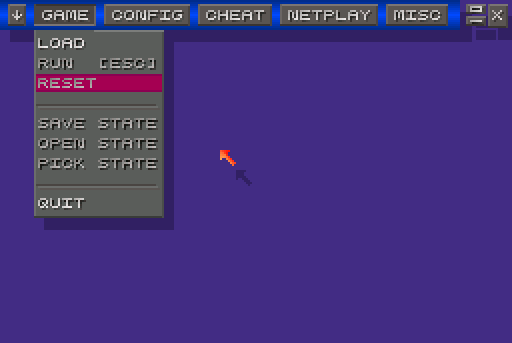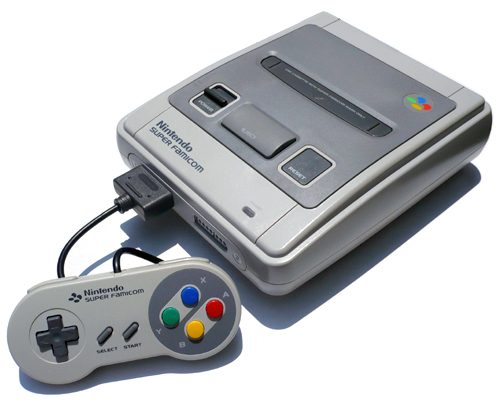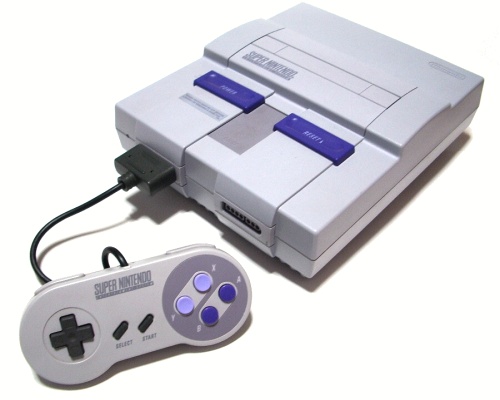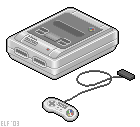I was playing Strider on my Mega Drive today (my SNES still hasn't arrived) and it made me think how much emulation has contributed to expanding the Retro Gaming market and its community. I wouldn't have bought Strider if I didn't have the chance to try it out on an emulator first, you see. So I decided to share my thoughts on emulation and its ethical dilemmas (the legal dilemmas are up to the judges to decide).
First a quick history lesson. Console emulation on PC was first achieved in the 90s. During the decade's final years (96-99) there were emulators released for the NES, SNES and Mega Drive. Even more shockingly 1999 saw the release of Bleem and UltraHLE, emulators for the Playstion and N64 respectivly. Now one can't argue with the fact that emulators for systems still in production would have been used mostly for piracy, so of course legal battles followed.

Meanwhile, a vast number of emulation and rom sharing sites were appearing all over the place and the old machines, that had been decommissioned by their manufacturers were seeing renewed interest, and a huge influx of new fans.
Everyone still had slow PSTN internet connections at the time (for those too young to remember this, I envy you. The jjjzzzjjzzzzzzjjj of connecting to the internet is a sound I will never miss, although it still makes me smile/laugh when I hear it in parodies) so downloading something as big as a PSone game was a pain, so at the time emulation sites mainly focused on cartridge consoles, specially the NES, SNES and Mega Drive (some sites were afraid to carry N64 roms due to possible legal action from Nintendo).
It was a prosperous time for emulation forums and the emulation scene in general. People who had downloaded an emulator to play those popular games from their childhoods, were trying new stuff. Games that most people hadn't heard of before, were the hot topic. Chrono Trigger finally got the giant fanbase it deserves and people finally got to try out obscure Japanese shooters they hadn't heard of before. The discussions about these games went on and on for many forum pages, and every month it seemed there would be a "new" game everyone was trying and loving.
[img width=350 height=307]http://pressthebuttons.typepad.com/.a/6a00d83452033569e20120a54f77a2970b-800wi[/img]
This led to the creation of the rom hacking community. From level hacks for Super Mario World, to the fan translations of FF5 and 6 (even though it had been officially released in the West, fans wrote a more accurate translation of the game's script) we retro gamers ow a lot to these people for taking the time to give us new experiences for the old games we love, or in the case of translation patches, giving us the option of playing games we would not be able to otherwise.
But the effect the emulation scene that I want to talk about, is the creation of the Retro Community. Simply put the Retro Gaming Community wouldn't have had so many members if it wasn't for emulation. Even though the most popular games keep getting ported to newer systems, there are tons of games either stuck in licensing limbo, or even worse with very little fan following to be worth porting to new consoles. What breathes life to these game's fanbase and the retro gaming community in general, is that every gamer that comes across their first emulator, has his/her interest piqued by the more common gems and after they are done with them, they want to see more of what these old consoles have to offer. Then they come across the more obscure gems, and after playing them they start to warm up to the idea of owning one of these old consoles and try playing these games like they were meant to.
[img width=397 height=58]http://www.racketboy.com/wp-content/themes/racketboy/images/header.jpg[/img]
The past 5 years, Retro Gaming associated sites and shops have bloomed. Part of it is because of the expansion of the internet into almost every household, but I believe emulators played a big part in it as well. 2005 saw the release of the first issue of an actual printed magazine dedicated to Retro Gaming (http://www.retrogamer.net/). Technically this would have been possible in the 90s as well, since by 95 there were 20 years of mainstream retro gaming to cover. But the Retro Community wasn't big enough. What has created a viable market for such a magazine to exist, is in my opinion the vast expansion of the community in the past decade, thanks to emulators.
[img width=350 height=452]http://www.retrogamer.net/issues/RG_051.jpg[/img]
Even Nintendo should be thankful to the emulation scene. Simply put, no one would have cared that Sin and Punishment was being released on the Wii's virtual console, if it hadn't made a name for itself in the emulation scene. While they might have lost a couple of sales to people who just pirate old classics, there are a bunch of gamers who buy these rare gems on VC, because they first tried them out on an emulator.
So even though using emulators for machines/games you don't own is a form of piracy, I believe that in general, they have done more good than harm to the industry. I also want to add that it's thanks to emulation that I was exposed to the SNES's magnificent hidden library, which made me buy one.
[img width=512 height=448]http://retrojrpg.thefannish.org/wp-content/uploads/retrojrpg.thefannish.org/2010/10/robotrek_robot.png[/img]
So what is your favorite system/game you found out about thanks to emulation? Mine is the Megaman X series (somehow I ended up not owning a console with Megaman games on it until I got the GBA in 2002) and Robotrek.
[img width=99 height=56]http://www.rfgeneration.com/images/blog/left/3796.png[/img]
So I'm still waiting for my SNES to be shipped to me. It should have been sent today, but I still haven't received any update on my order's status, so I'm still waiting on that. Anyway to pass the time and to get myself hyped up over my new console I've been browsing the internet for everything SNES. I've found some stuff that might interest some of you so I decided to share it here on this blog.
First of all and most urgent is this auction over at GameGavel for an SNES SNS-101 (which Zagnorch over at the comments said is pretty rare) or as the auctioneer and videogame pricecharts.com are calling it an SNES mini, which I have to say is a much better name and the one I'm going to be using from now on.
http://www.gamegavel.com/....cgi?show_item=0000460782
[img width=700 height=525]http://i392.photobucket.com/albums/pp10/rlamere/Auction%20Pics/Jan%2010/DSCN4390.jpg[/img]
The console comes with a copy of Super Mario World and at 45$ + shipping, it's an ok bargain compared to ebay.
Over at Racketboy, the great Princess-Isabela made the entire forum go wild with her awesome sales thread http://www.racketboy.com/...2&t=27424&start=0. She has a bunch of SNES NTSC games and some Super Famicom games for sale which are worth checking out.
[img width=640 height=480]http://img4.imageshack.us/img4/7527/dsc06579o.jpg[/img]
Lastly I was browsing Deviant Art and found this lovely piece of fan art by Murasaki-Hoshi and I felt like sharing it with you guys here.
[img width=700 height=990]http://th03.deviantart.net/fs11/PRE/i/2006/218/7/c/SNES_girl_by_Murasaki_Hoshi.jpg[/img]
Well that's it for now. Hopefully my SNES will come soon so I can start posing about games.
Also I would like to say that I'm interest in buying a loose cartridge of Robotrek (the Enix RPG), preferably with the manual. If anyone is selling a copy at a reasonable market price, please contact me. Thank you for reading.
[img width=99 height=56]http://fc04.deviantart.net/fs18/f/2007/190/5/c/SNES_stamp_by_Rashoodz.png[/img]
Hello and welcome to Super Nintendo Land!
So while I wait for my Super Famicom to arrive (more info on that at a later date), I decided to start posting my experiences on SNES collecting.
As any retro gamer knows, when buying a retro console it a good idea to research which one you'll be buying. Should I get the Mega Drive 1 or 2? Should I get the GBA SP or the smaller GBA Micro? Oh wait the Micro doesn't support GB and GBC games let me think this through.
So when I decided to get a SNES, besides looking at each region's exclusive games (although removing the lockout chip cancels out that factor, which is exactly what I did) I looked around to see what options I have hardware wise.
First factor was money. As anyone who has made it through middle school can tell you, prices are a matter of supply vs demand. How does that apply to retro gaming? First of all demand will always fluctuate. It can depend on a plethora of factors, with the most important in my mind being coverage. A single mention of a game as a hidden gem on Racket Boy or Retro Gamer might hike the price of said game on ebay. Likewise a recent release of a game on the Virtual Console might push some people to look for the original cart online. So it really all depends on luck with these out of production consoles.
But supply is much easier to calculate. Simply put, the more a console has sold the easier it is to find one. Gameboys are as cheap as chips and I've bought magazines that cost more than what the PS1 is going for right now on ebay. Anyway let's look at the regional sales of the SNES.
According to this document ( http://www.webcitation.org/5nXieXX2B ) which I shamelessly took from wikipedia, the SNES sales break down like this:
| America | 23 Million | | Japan | 17 Million | | Other | 8.5 Million |
So understandably it's much cheaper to look for a Super Famicom or an American SNES than a PAL or Korean one. I got my Super Famicom for 25 British Pounds (38$/30 Euro). On the various European ebay sites (co.uk .fr .es .it .de) a PAL Super Nintendo usually goes for at least 40 Euro (33 British Pounds/52$) In both cases with a single controller and the cables included. But price wise the crown goes to the American SNES. Right now it is being sold on ebay, for way less than the JP and EU models. The original SNES seems to go for about 20$ (15 Euro/13 British Pounds). Unfortunately I could not find any SNES SNS-101 (the redesigned model, which wasn't released in Europe btw) for sale, but only a couple of clones (I'll cover this issue in a minute), and the Super Famicom Junior is selling right now for crazy amounts of money (at least on the Western ebay sites, I don't know how much it costs in Japan).
So with price out of the way, let's look at what we collector's really care about (besides the games library). The design (aka the "looks") of a console. There are 3 main contenders in this category.
The original Super Famicom/ Super Nintendo PAL design

These are nearly identical to each other, with the only difference being the logo on the console itself and the controller (the PAL one has the Nintendo logo inside the ring thingy and it says Super Nintendo with big letters instead of Super Famicom with smaller ones. Here's a picture for comparison's sake http://upload.wikimedia.o...00.jpg/700px-SNES_800.jpg. Pictures, as always, shamelessly taken from Wikipedia).
So what do I like about this design. Well basically it's playfulness. This and the PSone have been the only console designs that basically say Hi there, I'm a box of joy. Everything, from the curvy design to the colorful logo and buttons says that when you'll interact with this magical machine you'll be having a great time. I also like how each button on the console is a totally different shape, to emphasize its different use (god knows how many times I pressed the wrong button on the Gamecube... well 2 or 3 times, but I was trying to make a point)
Next we have the American SNES

God what an ugly beast. Yup this is stereotypically American. You guys like your stuff big and that's perfectly fine (you're the only ones with space to put it in anyway. Try driving your cars in European capitals or in Tokyo). But all jokes aside, it's not the size I have a problem with. It's the overall design. First of all, why purple? Ok you wanted to promote it as a more serious machine, so the colorful details had to go, but you chose to replace them with purple buttons? WTF Nintendo? Nintendo Red goes sooooo well with dark gray, so why didn't you go with that instead? It's not like purple means less kiddy than red. What's up with Nintendo and purple anyway? The Gamecube was mostly pushed as a purple console, likewise with the GBA (the clear purple color was what most Europeans got anyway).
But by far the worst offender is the design itself. Once more I understand they needed to promote it as a more serious machine (to combat Sega's Marketing campaign), so with that in mind it makes perfect sense that they changed the buttons to look alike. But why did they have to place the reset button down there? And why is the front so loaded and the back so empty? I do like the curvy cartridge slot, but that's an element taken from the original design and I don't like that it's so clumsily elevated.
Lastly there's the Super Famicom Jr/ Super Nintendo SNS-101

This time they barely changed anything for the North American release, other than the color of the buttons and the logo (http://www.spaghettioh.co...tent/snes/snes_model2.jpg). I don't know which design I like more though. Well the SNS-101 is actually a huge improvement on the NA Super Nintendo so it's a good choice for someone in the market for an American SNES, plus the small purple buttons look kind of cute. On the other hand the Super Famicom Jr looks bad imo. The colorful logo this time makes it look like a baby's Super Famicom. I don't like either version much, but if I had to choose between these 2 I'd probably get the American version (with a PAL/JP controller  ). ).
A word of warning for those in the market for an SNES SNS-101. A wide variety of clone machines have been based on its design, so be careful when buying a SNS-101 from ebay, that you don't end up with a clone instead.
Finally there are the technical differences between models. In this regard the PAL consoles are inferior to all other regions, because they run at 50Hz. You can mod the console to make it run the games at 60Hz, but unless you have the technical skills to do that (or know someone who is willing to do that for you (for free or with payment)) I'd stick away from the PAL machines if you are given the option of choosing among the 3 regions (as always game libraries are not taken into account since you can make your SNES region free more easily than the 50/60Hz mod), unless you really like the design and your machine MUST say Super Nintendo on it.
Both Super Famicom and NA SNES run at 60Hz and can output composite video, S-Video and RGB signals, as well as RF with an external RF modulator. (All together now, "Shamelessly taken from Wikipedia"). On the other hand the Super Famicom Jr and the SNES SNS-101 don't output S-Video and RGB signal and don't feature an expansion port (although with the Satellaview service discontinued in 2000 there's no real need for one anyway).
So after taking account of the price, design and hardware factors I personally decided I wanted a Super Famicom. I'd have preferred a PAL Super Nintendo (I'm getting a mod for 50/60Hz switch anyway) but they are a bit more expensive and I'd rather spend that money on some games.
Thanks for reading. I'll try to update this blog whenever I have the time and I'm in a good mood, with my experiences in SNES collecting and its games in general.
[img width=99 height=56]http://fc04.deviantart.net/fs18/f/2007/190/5/c/SNES_stamp_by_Rashoodz.png[/img]
|



